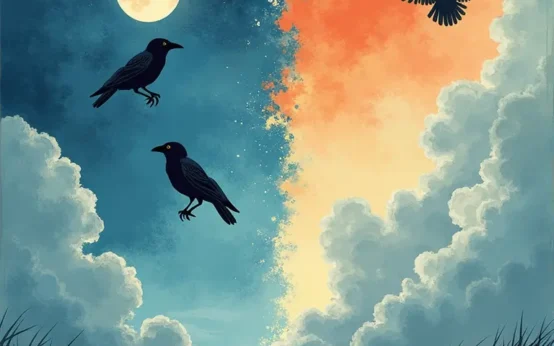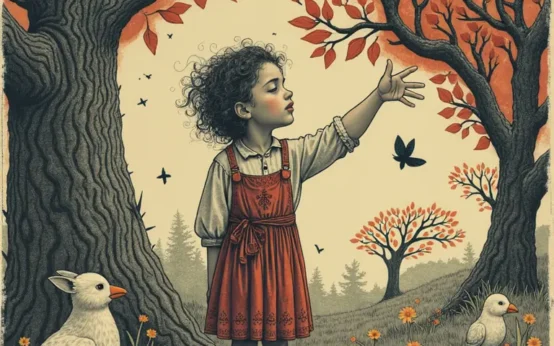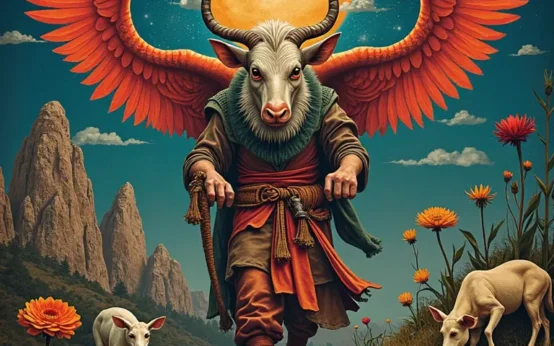For millennia, before the advent of satellites, radar, and complex meteorological models, humanity relied on a different kind of weather forecasting: observation. Not just casual observation, but a deeply ingrained, culturally-transmitted knowledge system known as weather lore. This wasn’t simply superstition, though it often gets dismissed as such. It was a practical science, honed over generations of farmers, sailors, and everyday people, who learned to read the subtle cues of the natural world to anticipate changes in the weather. This article delves into the fascinating world of weather lore, exploring its historical roots, the scientific basis (where it exists), and the wealth of proverbs and signs that once guided lives.
A History Rooted in Survival
The origins of weather lore are inextricably linked to the development of agriculture. Early farming communities were entirely dependent on predictable weather patterns for successful harvests. A late frost, an unexpected drought, or a severe storm could mean the difference between survival and starvation. Consequently, people became meticulous observers of the environment, noting correlations between natural phenomena and upcoming weather events. This knowledge wasn’t written down in textbooks; it was passed down orally through stories, rhymes, and proverbs, making it easily memorable and adaptable across generations.
Maritime cultures also played a vital role in refining weather lore. Sailors, far from land and reliant on their own senses, developed a keen understanding of the sea and sky. They learned to interpret cloud formations, wind patterns, and the behavior of marine life to predict storms and navigate safely. Their observations, like those of farmers, were critical for their livelihoods and survival. The transmission of this knowledge often occurred through apprenticeships and storytelling within seafaring communities.
The Scientific Basis – When Lore Meets Meteorology
While much weather lore appears anecdotal, a surprising amount has a basis in actual meteorological principles. It’s important to remember that pre-scientific observation often identified *correlations*, not necessarily *causations*. However, these correlations could often be explained, after the fact, by modern meteorological understanding.
Red Sky at Night, Shepherd’s Delight; Red Sky in Morning, Shepherd’s Warning
Perhaps the most famous weather proverb, this rhyme is remarkably accurate. A red sunset indicates that dry, stable air is moving in from the west. Dust and small particles in this air scatter blue light, allowing the longer wavelengths like red and orange to dominate. The dry air typically means good weather is on the way. Conversely, a red sunrise suggests that dry air has already passed, and a moisture-laden system (potentially bringing rain) is approaching from the west. This is a good example of how observing atmospheric particles can offer clues about approaching weather.
Ring Around the Moon
A halo around the moon (or sun) is caused by ice crystals in high cirrus clouds. These clouds often precede an approaching warm front and associated precipitation. The ice crystals refract and reflect light, creating the halo effect. While not an immediate predictor of rain, it signals a change in weather conditions is likely within 24-48 hours.
When Dew is on the Grass, Rain Will Never Come to Pass
This proverb relies on the principle of radiative cooling. Clear, calm nights allow the ground to cool rapidly, leading to condensation of water vapor as dew. The presence of dew indicates stable atmospheric conditions and a lack of cloud cover, making rainfall less likely. However, this is less reliable in humid climates.
Smoke Descends, Good Weather Bends
This observation is rooted in atmospheric stability. If smoke from a fire rises straight up, it indicates stable air. When the air is unstable, the smoke will disperse and descend. Unstable air is often associated with rising air currents, which can lead to cloud formation and precipitation.
A World of Signs: Animal Behavior as Predictors
Beyond atmospheric observations, weather lore often incorporates animal behavior as predictive indicators. This connection stems from the idea that animals are more sensitive to subtle environmental changes than humans.
Cows Lying Down
The belief that cows lie down before rain is widespread. While not universally true, there’s some scientific basis to it. Cows may lie down to conserve energy before a storm, as increased humidity and lower air pressure can make movement more difficult. However, cows also lie down for many other reasons (resting, chewing cud), so it’s not a foolproof indicator.
Birds Flying Low
Birds flying lower than usual is often interpreted as a sign of impending rain. This is linked to the increased presence of insects near the ground before a storm. Lower air pressure affects insect flight, bringing them closer to the ground, and birds follow the food source.
Frogs Croaking Loudly
Frogs tend to croak more loudly before rain. This is because they are more likely to breed during wet conditions. The increased croaking is a signal to attract mates in anticipation of rainfall.
Ants Building Higher Mounds
Ants are incredibly sensitive to changes in humidity. Before a flood or heavy rain, ants will often build up their mounds higher to protect their colonies from inundation. This is a remarkably accurate, though often overlooked, predictor of wet weather.
Regional Variations in Weather Lore
Weather lore isn’t uniform across the globe. Different cultures, shaped by their unique climates and environments, have developed their own specific proverbs and signs.
Europe
In Ireland, a common saying is “A rainbow in the morning gives water before evening.” In Germany, observing the thickness of onion skins is believed to predict the severity of the winter. Thick skins indicate a harsh winter, while thin skins suggest a mild one. Scandinavian folklore often focuses on the behavior of reindeer, believing their movements can predict snowstorms.
North America
Native American cultures possess a rich and detailed understanding of weather lore, often intertwined with spiritual beliefs. Many tribes observe the flight patterns of geese and the blooming of specific plants to forecast weather changes. The Powhatan tribe, for example, believed that a plentiful acorn harvest signaled a harsh winter. Appalachian folklore includes numerous proverbs related to the appearance of woolly bear caterpillars, with the width of the brown band supposedly indicating the severity of the coming winter.
Asia
In Japan, the flowering of cherry blossoms is a significant cultural event, but also a traditional indicator of the coming spring weather. The timing of the bloom is closely watched and believed to influence the rice harvest. Chinese weather lore incorporates the observation of cloud formations and the direction of the wind, with specific patterns associated with different types of weather.
The Decline of Weather Lore & The Rise of Science
With the advent of modern meteorology, weather lore gradually lost its prominence as a primary forecasting method. The ability to accurately predict weather patterns using scientific instruments and models diminished the reliance on traditional observations. However, to dismiss weather lore entirely would be a mistake. It represents a valuable body of accumulated knowledge, demonstrating humanity’s long-standing relationship with the natural world.
Furthermore, studying weather lore can offer insights into past climates and environmental conditions. The proverbs and signs reflect how people adapted to and interacted with their surroundings over centuries. It’s a form of cultural knowledge that deserves preservation.
Beyond Prediction: The Cultural Significance of Weather Lore
Weather lore extends beyond simply predicting the weather. It’s deeply embedded in cultural traditions, folklore, and literature. Many proverbs and signs are associated with agricultural practices, festivals, and daily life. They provide a framework for understanding the environment and our place within it.
The very act of observing and interpreting natural phenomena fostered a sense of connection to the land and a respect for the power of nature. It also encouraged community bonding, as knowledge was shared and passed down through generations. The storytelling aspect of weather lore often imbued it with a sense of mystery and wonder.
The Persistence of Superstition and Belief
It’s important to acknowledge the overlap between weather lore and superstition. Many beliefs are based on anecdotal evidence and lack scientific validation. However, the persistence of these beliefs speaks to the human tendency to seek patterns and meaning, even in random events. Understanding why we believe in seemingly irrational things is a fascinating area of study. For more on this, explore the psychology behind superstition.
Weather Lore and Other Traditional Knowledge Systems
Weather lore is part of a larger category of traditional ecological knowledge (TEK), which encompasses the accumulated wisdom of indigenous and local communities regarding their environment. TEK also includes knowledge about plants, animals, medicinal remedies, and sustainable resource management. Like weather lore, TEK is often passed down orally and is deeply rooted in cultural values.
Just as heraldry reveals historical and cultural insights through symbolic imagery, weather lore provides a glimpse into the past through its proverbs and observations. Similarly, the way smells evoke memories and shape cultural associations demonstrates the power of sensory experience, much like the keen observation skills required for weather lore.
The Enduring Appeal of Ancient Crafts
The skills needed to interpret weather lore often went hand-in-hand with other traditional crafts and knowledge systems. For example, understanding rope making – the art of knots – was essential for sailors relying on weather prediction for safe voyages. The interconnectedness of these skills highlights the holistic nature of traditional knowledge.
Rediscovering the Wisdom of the Past
While modern meteorology provides unparalleled accuracy in weather forecasting, there’s still value in revisiting weather lore. It reminds us of our connection to the natural world and the importance of observation. It encourages us to pay attention to the subtle cues that surround us, fostering a deeper understanding of the environment.
Furthermore, in a world increasingly reliant on technology, there’s something profoundly satisfying about being able to predict the weather using only your senses and a wealth of accumulated knowledge. It’s a connection to the past, a celebration of human ingenuity, and a reminder that wisdom can be found in the most unexpected places.


 The Surprisingly Consistent Science of Antique Barometers – Predicting Weather & Measuring Atmospheric Pressure
The Surprisingly Consistent Science of Antique Barometers – Predicting Weather & Measuring Atmospheric Pressure  The Surprisingly Consistent Logic of Traditional Weather Proverbs – Folklore’s Forecasts & Atmospheric Science
The Surprisingly Consistent Logic of Traditional Weather Proverbs – Folklore’s Forecasts & Atmospheric Science  The Unexpectedly Detailed World of Antique Keys: Locks, Lore & Lost Stories
The Unexpectedly Detailed World of Antique Keys: Locks, Lore & Lost Stories  The Unexpected Origins of Nursery Rhymes: Tales of History & Hidden Meanings
The Unexpected Origins of Nursery Rhymes: Tales of History & Hidden Meanings  Decoding Animal Superstitions: Origins & Global Beliefs
Decoding Animal Superstitions: Origins & Global Beliefs